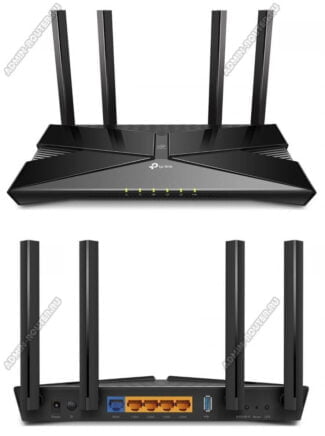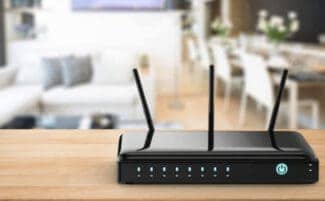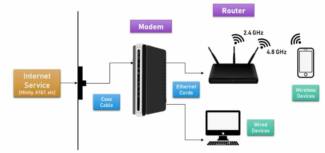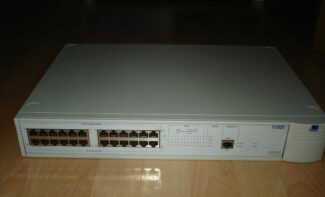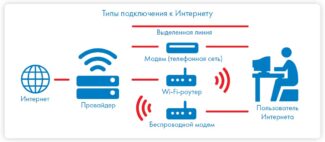Modern routers in most cases support a wireless network. This means that the connection of home devices to the Internet is made not only by cable, but also by Wi-Fi. In this context, there is also no difference between these concepts. The term "Wi-Fi router" is just as common as "wireless router."
![]()
Proof
The whole problem arose in the Russification of a new word in the IT market. On the one hand pure foreign borrowings coexist in this environment, on the other hand everyone loves russification. A little from the English dictionary:
I.e. router (or in the original Router) with this very suffix "er" – literally would be something like a route builder. The Russians simplified the translation solution and called it simply – "router". Bottom line:
It is the same device, just given different names in the translation. Both are getting along now.
I suggest you read more about what a router is here.
Where does the confusion come from?
It comes from nowhere, a lot of people are used to both names. Most people call this home device a router, that's how we got used to it. This is an example of taking the word "modem" – at home means and dial-up, and 3G USB and ADSL. That is a true people's word – "router. And the pros use it much more often.
On the other hand, there is the official part. So in high school we were taught the competent word "router". That's how they write it in technical literature, where a formal syllable is required. That's also how the stores picked up on it:
At the same time, the consultants of these same stores themselves will call them "routers". So on paper it's a router, but in words it's a router. Rather, the people confusion arose precisely on this contrast. Rather, no one has written about this dependency yet, so it's almost firsthand)
Choice
Depending on the design, routers are divided into industrial and household. In the first case, it is a specialized device. They are most often used to organize corporate networks, and the right choice is the responsibility of the network administrator, who is a technically trained specialist. On the other hand, with household routers, things are much more complicated. They are purchased by ordinary users, who are not well trained and knowledgeable specialists in this field. Therefore, we can give them the following recommendations:
- First of all, pay attention to the manufacturer. The best are considered to be the routers of D-Link, Asus and Zyxel brands.
- We pay attention to the maximum wireless network transmission speed. In most cases it is 150 Mbit/sec. But there are also devices capable of transmitting 300 Mbps. The more the better.
- Don't forget to check the package contents. Be sure to have, in addition to the router, power supply, user manual in Russian, one meter twisted pair cord for connection and initial setup, and a disc with drivers.
- Then we look at the modes of operation of the wireless network. There are only two options: "abg" and "bgn". If your smartphone is equipped with an "a" standard transmitter, it will not work in a router of the latter type. In general, everything must be coordinated and work in the same mode. Otherwise there may be problems with the connection.
Some stores, in order to confuse the ill-informed buyer more, tend to call network devices differently on the price tags. In this case, those that come with a foreign word are more expensive. If you ask a salesperson in such a store: "What is the difference between a router and a router, and why does the former cost more?", in most cases you will not be able to get a coherent answer. That is why it is better to avoid such outlets. The quality of products in them is usually questionable.
Settings
- Connecting the power supply, the input wire from the ISP and a meter twisted pair to your computer or laptop.
- Switching on the computer and the router. Be sure to wait for each one to finish loading.
- Start your browser and enter the network address: "192.168.1.1" (in some cases, the last two numbers may be "0.1" – see the manual).
- Specify the network name, the password to access it and the encryption method (it is best to choose WPA2 – the maximum security level).
- Reboot router, everything is ready.

What is a router?
The word "router" is derived from a direct transliteration of the English "router", which in turn comes from the word "route" (route). Among users and experts in computer networking it is used more often than "router". Therefore, another difference between these terms is the frequency of use of the term. There are also less common variants: "router" or "router," which are mostly used by inexperienced users.

A router is a miniature device equipped with several network interfaces. It is used for network routing – distributing traffic among different network clients (computers, servers, wireless gadgets). The most common routers have five Ethernet ports: the first one is used to connect the ISP cable, while the other four are used for wired connection of home network devices.

Note! The word "router" is used more often than "router", although the latter is a direct translation of the English original name.
Router: what kind of device is it and how does it work?
We all know that it is such a small box, usually with an antenna (or one), which gives us the opportunity to connect to the Internet via Wi-Fi.
In short and simple terms
routeris a device that distributes the Internet to devices connected to it. This can be done via a network cable (computers, TVs, etc.), or via Wi-Fi (smartphones, tablets, laptops).
Or so: the router connects all the devices into a local network (in which they can share files, or you can play games) with the ability to access the Internet (if the Internet is connected and configured).
And let me forgive the experts who will definitely spit on my explanation (especially on the word "distributes"), but I think it is much easier to understand what kind of device this is.
The arrival of the routers
Time went on and then the ISPs started bringing fiber to the cities. It's faster Internet, more reliable, and cheaper. I remember, when I had fiber optic cable installed, I was surprised that I no longer needed a modem, and I had to say goodbye to that little box, to which I was addicted. I gave it to the workmen who had installed the fiber optic cable.
Now the Internet was transmitted by the right technology and the modem, which would decrypt the signals on the phone line is simply not needed. Now the Internet wire is plugged directly into the computer, there are no breaks, the speed is crazy and I am happy.
It took another 5 years and began to appear cool phones and wide displays and the first devices on which there was a Wi-Fi module is such a thing that is able to connect to a wireless, aerial network.

At home, everyone was using a smartphone or a tablet. And the question arose as to how to unite all these people so that they have access to the Internet at home. After all, mobile at the time was very expensive and, most importantly, not unlimited. Yes, there were such terrible times, when it was a gigabit and expensive.
That was when I first got to know my first router. I brought it home and started fiddling with the settings. I had the task to build a Wi-Fi network, connect the Internet to it and distribute it to all the home devices.
- The Internet cable from the entrance hall went inside the apartment and plugged into the router.
- From this box went to the usual network wire to my desktop computer.
- Having set up the Internet, it was now on the computer and all the devices that are connected to the wireless wi-fi network.
All the family was happy, because now on smartphones, phones, tablets and laptops was a good, stable and fast Internet.
Read More:
